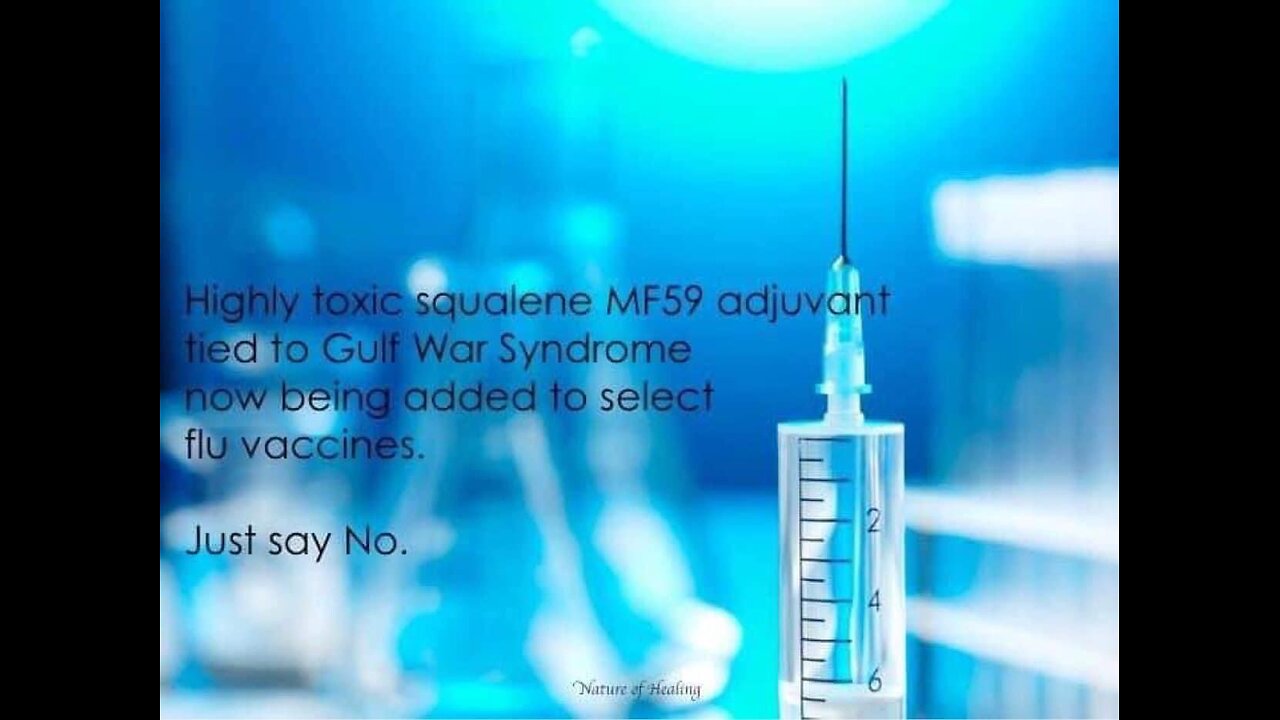Premium Only Content

Project Badger / Motherfucker 59 ( MF59 ) / Micoplasma Fermentans / CAS-9 mRNA Genetic Mutation 💉
Vaccine A
1.) https://slate.com/technology/2004/11/did-the-military-secretly-doctor-the-anthrax-vaccine.html
Anthrax Scare
Did the military secretly doctor its anthrax vaccine?
BY JON COHEN
NOV 16, 20044:00 PM
In Vaccine A: The Covert Government Experiment That’s Killing Our Soldiers—and Why GI’s Are Only the First Victims, Gary Matsumoto struggles for nearly 300 pages to justify his book’s subtitle. Matsumoto’s contention, as he first reported in a 1999 Vanity Fair article that triggered a congressional hearing, is that the U.S. military’s anthrax vaccine causes a constellation of autoimmune diseases and symptoms such as lupus, rashes, hair loss, and aching joints that fall under the rubric known as Gulf War Syndrome. He makes the case that the military secretly spiked the vaccine with squalene, a fat naturally found in the body that, when injected as part of a vaccine, supercharges the immune system’s ability to make antibodies. He accuses the Department of Defense of slipping this experimental vaccine past the Food and Drug Administration and involving unwitting troops in a human test that Matsumoto repeatedly equates with Nazi experimentation and the infamous Tuskegee syphilis study. The vaccine harmed “possibly tens of thousands” of troops, he warns, and millions of doses now are being prepared for public use.
Autoimmune Technologies LLC, New Orleans Gulf War Syndrome ANTI-SQUALENE ANTIBODIES LINK GULF WAR SYNDROME TO ANTHRAX VACCINE Data published in the February 2000 and August 2002 issues of Experimental and Molecular Pathology strongly suggests that Gulf War Syndrome is caused by a vaccine contaminated with squalene.
The August 2002 article is entitled "Antibodies to Squalene in Recipients of Anthrax Vaccine" (Exp. Mol. Pathol. 73,19-27 (2002)).
Gulf War Syndrome, or GWS, is the term which has been applied to the multi-symptom rheumatic disorder experienced by many veterans of the 1990-1991 Persian Gulf war.
A similar disorder appeared in 1990-1991-era personnel who were never deployed to the Persian Gulf theater of operations and also in other military personnel, including participants in the Anthrax Vaccine Immunization Program, or AVIP, which was inaugurated in 1997.
No data has ever suggested that the disorder experienced by the deployed 1990-1991 soldiers is different from the disorder experienced by the other groups of patients, but the other cases have not been considered to be cases of GWS.
Squalene was found by the U.S. Food and Drug Administration in five lots of the AVIP anthrax vaccine.
The discovery of serum anti-squalene antibodies and the development of a test to detect these antibodies has made it possible to see that links appear to exist between the contaminated AVIP vaccine lots, the illness experienced by post-1997 vaccine recipients, the illness experienced by non-deployed 1990-1991-era patients, and the illness in deployed 1990-1991-era patients that has been referred to as GWS.
The data establishing these links is presented in the peer-reviewed February 2000 and August 2002 articles. The published findings (1) strongly suggest that the GWS-like illness being reported by all of the various patient groups is the same illness, (2) strongly suggest that the contaminated vaccine caused the illness in the AVIP group, and (3) further suggest that squalene contamination of one or more 1990-1991-era vaccines accounts for the GWS cases from that era.
Before the anti-squalene antibody test was developed, there was no specific laboratory test for GWS. Both articles suggest that the antibodies can serve as an excellent laboratory marker to help identify patients with GWS. ( Asa Assay Test named after Dr. 👩⚕️ Pamela Asa - along with Dr. Robert F. Garry from their joint research at Tulane University / as for Dr. Pam Asa, whereabouts unknown - she was an email friend of mine. I don’t even know if she is alive or dead.
( Tom Trefts ). Please see the book 📕 Vaccine 💉 A by Gary Matsumoto.
Using the antibodies as a laboratory marker for GWS could be very useful in helping physicians diagnose the disorder and in differentiating it from other rheumatic illnesses.
Anti-squalene antibodies might also provide a key to more effectively treating GWS patients.
The presence of the antibodies in GWS patients indicates that the immune system is involved in the development of GWS. Effective drugs which modulate the human immune system are already in wide use, but they have not been previously considered to be appropriate for GWS patients.
The published data now suggests that the use of immune modulators in GWS patients should be studied. A detailed discussion of the data in the February 2000 and August 2002 articles can be found in the Autoimmune Technologies news release dated July 15, 2002.
Further information about the discovery of squalene in the AVIP vaccine lots can be found in the statement made by former U.S. Congressman Jack Metcalf on September 27, 2000 to the House Subcommittee on National Security, Veterans Affairs, and International Relations.
In March 1999, the United States General Accounting Office (the GAO) encouraged the Department of Defense to investigate the discovery of anti-squalene antibodies. In GAO/NSIAD-99-5, "Gulf War Illnesses - Questions About the Presence of Squalene Antibodies in Veterans Can Be Resolved," the GAO urged the DoD to conduct its own research into anti-squalene antibodies with two objectives in mind: (1) to confirm the existence of the newly-discovered antibodies, and (2) to acquire patient data, explore the apparent link between the antibodies and the illness in GWS patients, and attempt to confirm or disprove the existence of such a link. Click on GAO/NSIAD-99-5 for a PDF version of this report. See Notes on PDF Files if you would like help with the PDF format.
-
 LIVE
LIVE
The Shannon Joy Show
1 hour ago🔥🔥Live Exclusive With Dr. Peter McCullough! RFK Jr. Confirmation Coverage & More!🔥🔥
268 watching -
 2:07:01
2:07:01
Steven Crowder
3 hours agoTrump’s Funding Freeze: Fact-Checking the Mainstream Media Lies
194K126 -
 DVR
DVR
Bannons War Room
1 year agoWarRoom Live
110M -
 43:59
43:59
MYLUNCHBREAK CHANNEL PAGE
2 hours agoWho REALLY Built Our Cities?
8.89K5 -
 38:25
38:25
Rethinking the Dollar
1 hour agoTrump Media Group Dives into Crypto with Truth.Fi Launch
5.47K1 -
 1:30:06
1:30:06
Graham Allen
4 hours agoThe Border Is CLOSED!! 92% Less Crossings!! + Pete Hegseth Is GOING AFTER Mark Milley!
65.5K58 -
 13:51
13:51
Dr David Jockers
2 hours agoUltimate Fat-Burning Hack: What They Don’t Tell You!
5.47K1 -
 2:58:55
2:58:55
Wendy Bell Radio
7 hours agoUnapologetic
83.8K52 -
 2:09:04
2:09:04
Matt Kohrs
11 hours agoBUCKLE UP! IT'S FED RATE DAY!!! || The MK Show
33.5K3 -
 52:05
52:05
Randi Hipper
2 hours agoBITCOIN PRICE REBOUNDS AS MORE STATES REVEAL RESERVE PLANS
7.67K2